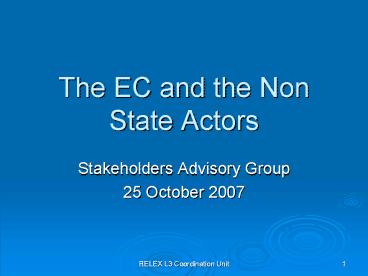The EC and the Non State Actors - PowerPoint PPT Presentation
1 / 12
Title:
The EC and the Non State Actors
Description:
Sometimes shorter process : e. g. one big workshop in India; ... Mostly through the thematic budget lines (mainly: NGO, EIDHR, environment, food security... – PowerPoint PPT presentation
Number of Views:22
Avg rating:3.0/5.0
Title: The EC and the Non State Actors
1
The EC and the Non State Actors
- Stakeholders Advisory Group
- 25 October 2007
2
Introduction
- Process some information on NSAs/LAs involvement
and consultation was already available.
Delegations were requested to provide extra
information to fit the DEV questionnaire. - Requests sent to Asia and Latin America
Delegations. 33 requests sent ? 19 answered 11
Asia and 9 Latin America - Asia Afghanistan, Bangladesh, China, India,
Indonesia, Lao, Mongolia, Pakistan, Philippines,
Sri Lanka, Vietnam - Latin America Argentina, Brazil, Costa Rica,
Guatemala, Panama, Paraguay, Uruguay, Venezuela - A rapid scan of the answers provided us with the
information presented today. More in-depth study
and report will be done at a later stage.
3
EC works with a Wide range of NSAs
- European, local and regional NGOs networks
- cooperative associations
- local authorities and municipalities
associations networks - trade unions, business and organized economic
interest groups (like employer associations and
consumer associations) - universities, researchers and foundations, think
tanks
4
Mapping of the NSA situation
- Mapping studies exist or are considered China
Lao Chile (Venezuela) - Mapping study does not exist or is not considered
because - Initiatives have already been taken to gather
such information Argentina, India, Vietnam,
Bangladesh, Philippines - At this stage, it is difficult to produce such
study given the situation of the NSA in the
country (e.g. Afghanistan, Indonesia)
5
Involvement in the policy dialogue
- Linked to the country situation
- In some countries national forums involving
NSAs e.g. The Philippines Development Forum - The policy dialogue mainly takes place in a
sectoral framework (e.g. around SWAPs education
sector in Paraguay trade sector in China). - In some countries, the dialogue is limited for
the time being given the situation (e.g.
Afghanistan). In developing the (for the time
being limited) policy dialogue, the EC intends to
include the NSAs (e.g. Mongolia). - Example of a specific space set up for dialogue
EU-CSOs the EU-Central America Civil Society
Forum on regional integration.
6
Involvement in policy dialogue
- Coordination between EC and MS offers also
possibilities for policy dialogue with civil
society (Peru, Bangladesh). - Main topics discussed future programming
priorities, human and social development, human
rights, governance, decentralization process,
economic cooperation modalities, regional
integration, migration, corruption, environment,
gender, need for HIV/AIDS mainstreaming, rural
development
7
NSAs consultation in the programming process
How this consultation was organized?
- Most of the time, initiated by the Delegation.
Uruguay both Delegation and Government. - Most used scheme meetings and workshops
(regional, national and/or local) on concept
notes/draft CSP or on specific issues relevant
for the CSP - Scheme followed in several Central America
countries - pre-programming mission/pre-consultation,
drafting of a concept note, website consultation,
workshops around the concept note, seminars
around the draft CSP - Indirectly via a national development process
(Afghanistan).
8
Type of consultations
- Consultative type main type used (16
countries) - Several stages of meetings, involvement in the
preparation of the drafts, inputs taken into
account Sometimes shorter process e. g. one
big workshop in India - More informative type Lao (Sri Lanka,
Afghanistan)
9
Involvement in implementation
- Mostly through the thematic budget lines (mainly
NGO, EIDHR, environment, food security) - Also implementation of geographical programmes
- human and social development (e.g. in
Afghanistan) - rural development (e. g. in Mongolia)
- economic development (e. g. Panama),
- culture (India),
- decentralization (e.g. Costa Rica).
10
NSA/LA capacity building
- Main source will be thematic programme on NSA
LA (in the past NGO budget lines) - Annual Action
Programme 2007 total EC contribution
207.852.900. Support is also foreseen through the
EIDHR programme. - Through the geographical programmes mostly in
the framework of sectoral activities - Health, education, social cohesion, trade and
development of SMEs, regional integration... - Or as specific governance focus (e.g. China the
Governance for Equitable Development).
11
Main Preliminary Findings
- Preliminary findings based on the first
information gathered. Need to be more developed
and precised to allow us to formulate concrete
recommendations. - In general, the Delegations have a quite positive
assessment of the role and input of NSAs. However
this can vary quite significantly from one
country to another and within the same country
from one NSA to another because of the different
levels of capacity and resources - Thematic and regional programmes are often put at
the forefront by the Delegations as useful tools
to involve and support NSAs/LAs. Examples of
regional programmes - ALFA focuses on the promotion of co-operation in
higher education between the two regions - ATLAS relations between Chamber of Commerce
- ASIA URBS city-to-city cooperation between
Asian and European local governements.
12
- The consultation process has taken place in most
of the Delegations but sometimes the process had
to be limited due to time constraints. Most of
the Delegations mentioned that the NSAs remarks
were taken into account in the drafting of the
CSP. ? A more structured and regular dialogue is
needed. - Major obstacles identified for the involvement of
NSAs/LAS are capacity and resources limits. In
this framework, capacity support for NSAs/LAs is
foreseen for most of the countries mostly
through the Thematic Programmes. ? NSAs/LAs
capacity building must be a priority goal.





![[PDF] DOWNLOAD Extraterritorial Use of Force Against Non-State Actors (Oxford Monographs in PowerPoint PPT Presentation](https://s3.amazonaws.com/images.powershow.com/9916297.th0.jpg?_=20230804066)

























